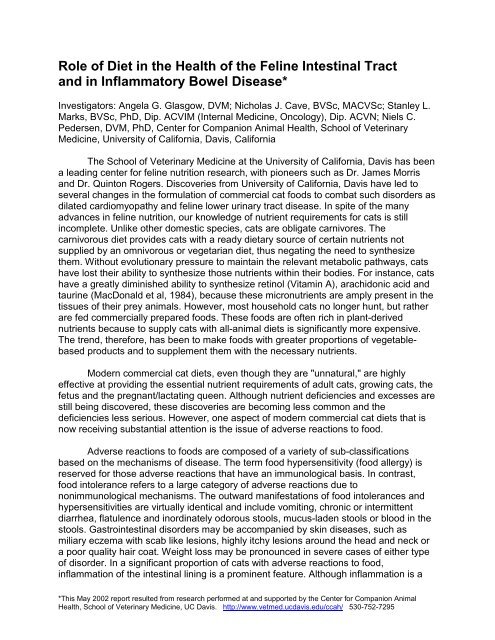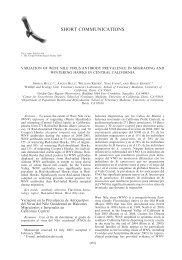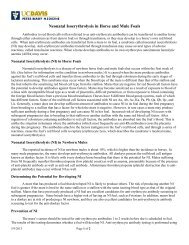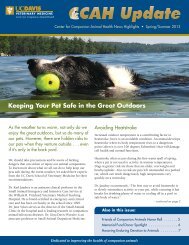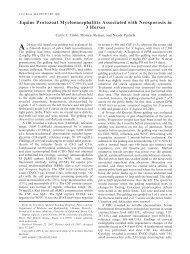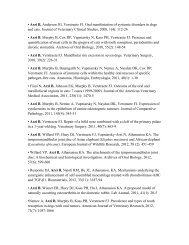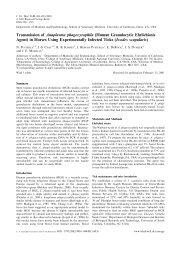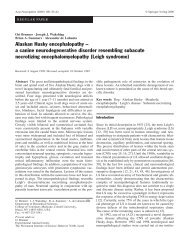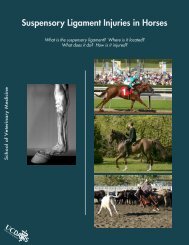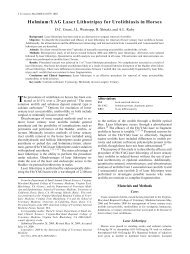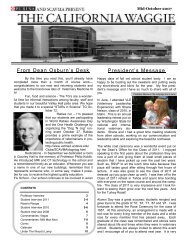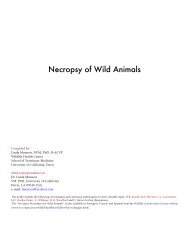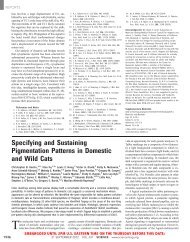Role of Diet in the Health of the Feline Intestinal Tract - School of ...
Role of Diet in the Health of the Feline Intestinal Tract - School of ...
Role of Diet in the Health of the Feline Intestinal Tract - School of ...
You also want an ePaper? Increase the reach of your titles
YUMPU automatically turns print PDFs into web optimized ePapers that Google loves.
<strong>Role</strong> <strong>of</strong> <strong>Diet</strong> <strong>in</strong> <strong>the</strong> <strong>Health</strong> <strong>of</strong> <strong>the</strong> Fel<strong>in</strong>e Intest<strong>in</strong>al <strong>Tract</strong><br />
and <strong>in</strong> Inflammatory Bowel Disease*<br />
Investigators: Angela G. Glasgow, DVM; Nicholas J. Cave, BVSc, MACVSc; Stanley L.<br />
Marks, BVSc, PhD, Dip. ACVIM (Internal Medic<strong>in</strong>e, Oncology), Dip. ACVN; Niels C.<br />
Pedersen, DVM, PhD, Center for Companion Animal <strong>Health</strong>, <strong>School</strong> <strong>of</strong> Veter<strong>in</strong>ary<br />
Medic<strong>in</strong>e, University <strong>of</strong> California, Davis, California<br />
The <strong>School</strong> <strong>of</strong> Veter<strong>in</strong>ary Medic<strong>in</strong>e at <strong>the</strong> University <strong>of</strong> California, Davis has been<br />
a lead<strong>in</strong>g center for fel<strong>in</strong>e nutrition research, with pioneers such as Dr. James Morris<br />
and Dr. Qu<strong>in</strong>ton Rogers. Discoveries from University <strong>of</strong> California, Davis have led to<br />
several changes <strong>in</strong> <strong>the</strong> formulation <strong>of</strong> commercial cat foods to combat such disorders as<br />
dilated cardiomyopathy and fel<strong>in</strong>e lower ur<strong>in</strong>ary tract disease. In spite <strong>of</strong> <strong>the</strong> many<br />
advances <strong>in</strong> fel<strong>in</strong>e nutrition, our knowledge <strong>of</strong> nutrient requirements for cats is still<br />
<strong>in</strong>complete. Unlike o<strong>the</strong>r domestic species, cats are obligate carnivores. The<br />
carnivorous diet provides cats with a ready dietary source <strong>of</strong> certa<strong>in</strong> nutrients not<br />
supplied by an omnivorous or vegetarian diet, thus negat<strong>in</strong>g <strong>the</strong> need to syn<strong>the</strong>size<br />
<strong>the</strong>m. Without evolutionary pressure to ma<strong>in</strong>ta<strong>in</strong> <strong>the</strong> relevant metabolic pathways, cats<br />
have lost <strong>the</strong>ir ability to syn<strong>the</strong>size those nutrients with<strong>in</strong> <strong>the</strong>ir bodies. For <strong>in</strong>stance, cats<br />
have a greatly dim<strong>in</strong>ished ability to syn<strong>the</strong>size ret<strong>in</strong>ol (Vitam<strong>in</strong> A), arachidonic acid and<br />
taur<strong>in</strong>e (MacDonald et al, 1984), because <strong>the</strong>se micronutrients are amply present <strong>in</strong> <strong>the</strong><br />
tissues <strong>of</strong> <strong>the</strong>ir prey animals. However, most household cats no longer hunt, but ra<strong>the</strong>r<br />
are fed commercially prepared foods. These foods are <strong>of</strong>ten rich <strong>in</strong> plant-derived<br />
nutrients because to supply cats with all-animal diets is significantly more expensive.<br />
The trend, <strong>the</strong>refore, has been to make foods with greater proportions <strong>of</strong> vegetablebased<br />
products and to supplement <strong>the</strong>m with <strong>the</strong> necessary nutrients.<br />
Modern commercial cat diets, even though <strong>the</strong>y are "unnatural," are highly<br />
effective at provid<strong>in</strong>g <strong>the</strong> essential nutrient requirements <strong>of</strong> adult cats, grow<strong>in</strong>g cats, <strong>the</strong><br />
fetus and <strong>the</strong> pregnant/lactat<strong>in</strong>g queen. Although nutrient deficiencies and excesses are<br />
still be<strong>in</strong>g discovered, <strong>the</strong>se discoveries are becom<strong>in</strong>g less common and <strong>the</strong><br />
deficiencies less serious. However, one aspect <strong>of</strong> modern commercial cat diets that is<br />
now receiv<strong>in</strong>g substantial attention is <strong>the</strong> issue <strong>of</strong> adverse reactions to food.<br />
Adverse reactions to foods are composed <strong>of</strong> a variety <strong>of</strong> sub-classifications<br />
based on <strong>the</strong> mechanisms <strong>of</strong> disease. The term food hypersensitivity (food allergy) is<br />
reserved for those adverse reactions that have an immunological basis. In contrast,<br />
food <strong>in</strong>tolerance refers to a large category <strong>of</strong> adverse reactions due to<br />
nonimmunological mechanisms. The outward manifestations <strong>of</strong> food <strong>in</strong>tolerances and<br />
hypersensitivities are virtually identical and <strong>in</strong>clude vomit<strong>in</strong>g, chronic or <strong>in</strong>termittent<br />
diarrhea, flatulence and <strong>in</strong>ord<strong>in</strong>ately odorous stools, mucus-laden stools or blood <strong>in</strong> <strong>the</strong><br />
stools. Gastro<strong>in</strong>test<strong>in</strong>al disorders may be accompanied by sk<strong>in</strong> diseases, such as<br />
miliary eczema with scab like lesions, highly itchy lesions around <strong>the</strong> head and neck or<br />
a poor quality hair coat. Weight loss may be pronounced <strong>in</strong> severe cases <strong>of</strong> ei<strong>the</strong>r type<br />
<strong>of</strong> disorder. In a significant proportion <strong>of</strong> cats with adverse reactions to food,<br />
<strong>in</strong>flammation <strong>of</strong> <strong>the</strong> <strong>in</strong>test<strong>in</strong>al l<strong>in</strong><strong>in</strong>g is a prom<strong>in</strong>ent feature. Although <strong>in</strong>flammation is a<br />
*This May 2002 report resulted from research performed at and supported by <strong>the</strong> Center for Companion Animal<br />
<strong>Health</strong>, <strong>School</strong> <strong>of</strong> Veter<strong>in</strong>ary Medic<strong>in</strong>e, UC Davis. http://www.vetmed.ucdavis.edu/ccah/ 530-752-7295
common feature <strong>of</strong> many types <strong>of</strong> fel<strong>in</strong>e bowel disorders, <strong>the</strong> term "<strong>in</strong>flammatory bowel<br />
disease" (IBD) is reserved for those cases where no specific cause can be identified.<br />
Inflammatory bowel disease [IBD], <strong>the</strong> most common cause <strong>of</strong> chronic vomit<strong>in</strong>g<br />
and diarrhea <strong>in</strong> cats, is a disease <strong>in</strong> which diet may have an important role. The cl<strong>in</strong>ical<br />
course <strong>of</strong> IBD <strong>in</strong> cats may be <strong>in</strong>termittent at first, with periods <strong>of</strong> normalcy becom<strong>in</strong>g<br />
shorter. The <strong>in</strong>test<strong>in</strong>al wall becomes thickened by an <strong>in</strong>filtrate <strong>of</strong> <strong>in</strong>flammatory cells, and<br />
<strong>the</strong> microscopic and gross surface folds <strong>of</strong> <strong>the</strong> <strong>in</strong>test<strong>in</strong>al l<strong>in</strong><strong>in</strong>g are flattened, lead<strong>in</strong>g to a<br />
great loss <strong>of</strong> surface area. As <strong>the</strong> surface area is reduced, <strong>the</strong> ability <strong>of</strong> <strong>the</strong> cat to digest<br />
and absorb nutrients is reduced, lead<strong>in</strong>g to weight loss <strong>in</strong> <strong>the</strong> face <strong>of</strong> a normal or<br />
<strong>in</strong>creased appetite. The stools <strong>of</strong>ten become looser and <strong>in</strong> some cases, more odorous.<br />
A sequel <strong>of</strong> chronic IBD can be <strong>in</strong>test<strong>in</strong>al lymphosarcoma (lymphoma). These tumors<br />
may occur because <strong>of</strong> <strong>the</strong> notorious habit <strong>of</strong> cats to develop tumors at sites <strong>of</strong> chronic<br />
<strong>in</strong>flammation.<br />
The importance <strong>of</strong> IBD <strong>in</strong> cats has been an impetus for several studies at<br />
University <strong>of</strong> California, Davis. The role <strong>of</strong> abnormal immunological reactions to food<br />
components <strong>in</strong> IBD is <strong>the</strong> topic <strong>of</strong> research <strong>of</strong> Dr. Nick Cave <strong>in</strong> our Center for<br />
Companion Animal <strong>Health</strong>. Dr. Cave and his PhD supervisor, Dr. Stanley Marks, are<br />
measur<strong>in</strong>g antibodies directed aga<strong>in</strong>st dietary prote<strong>in</strong>s <strong>in</strong> normal cats, and compar<strong>in</strong>g<br />
those with antibodies measured <strong>in</strong> cats with IBD. It is suspected that <strong>in</strong> fel<strong>in</strong>e IBD,<br />
antibodies <strong>in</strong> <strong>the</strong> blood will be produced <strong>in</strong> significant amounts aga<strong>in</strong>st <strong>the</strong> ma<strong>in</strong><br />
dietary prote<strong>in</strong>s. In a prelim<strong>in</strong>ary study, 20 healthy cats fed a commercial diet had<br />
measurable levels <strong>of</strong> food-antibodies <strong>in</strong> <strong>the</strong>ir blood. Whe<strong>the</strong>r this is a normal feature <strong>of</strong><br />
cats or a peculiarity <strong>of</strong> consum<strong>in</strong>g commercial diets is unknown. This leads to <strong>the</strong><br />
second question, namely, to what degree does <strong>the</strong> commercial food manufactur<strong>in</strong>g<br />
process lead to abnormal immune responses and could such processes be <strong>in</strong>volved <strong>in</strong><br />
<strong>the</strong> <strong>in</strong>itiation or perpetuation <strong>of</strong> IBD <strong>in</strong> cats? This group will be address<strong>in</strong>g this issue by<br />
describ<strong>in</strong>g <strong>the</strong> immune responses <strong>in</strong> healthy cats to dietary prote<strong>in</strong>s fed ei<strong>the</strong>r raw, or as<br />
part <strong>of</strong> a canned diet.<br />
The role <strong>of</strong> diet <strong>in</strong> IBD is difficult to study because <strong>the</strong>re are many <strong>in</strong>gredients<br />
with<strong>in</strong> each food that potentially contribute to <strong>the</strong> disease. A diet that may cause<br />
problems <strong>in</strong> one cat may be perfectly f<strong>in</strong>e <strong>in</strong> ano<strong>the</strong>r. None<strong>the</strong>less, it is reasonable to<br />
speculate that cats fed a "natural diet" are less likely to develop IBD than cats fed<br />
"unnatural diets." The natural diet <strong>of</strong> cats does not conta<strong>in</strong> wheat, milk, soybean, egg or<br />
many o<strong>the</strong>r <strong>in</strong>gredients commonly used. Nor does <strong>the</strong> natural diet <strong>of</strong> cats conta<strong>in</strong><br />
additives and preservatives such as guar and xanthum gums as food stabilizers,<br />
propionic acid and sorbic acids as preservatives, or carrageenan (made from<br />
seaweed and shown to cause <strong>in</strong>test<strong>in</strong>al <strong>in</strong>flammation <strong>in</strong> certa<strong>in</strong> circumstances)<br />
(Strombeck, 1999). These <strong>in</strong>gredients, and many o<strong>the</strong>rs, are added to commercial diets<br />
to improve <strong>the</strong>ir appearance to <strong>the</strong> pet owners and palatability to pets, but may result <strong>in</strong><br />
an adverse reaction. The natural diet <strong>of</strong> cats is primarily small mammals, with a lesser<br />
proportion <strong>of</strong> <strong>in</strong>sects, reptiles and birds. There is an obvious need for a "gold standard<br />
diet" aga<strong>in</strong>st which to compare and study all "unnatural diets." Such a diet should be<br />
complete and balanced, relatively cheap, easily obta<strong>in</strong>ed and may need to mimic <strong>the</strong><br />
2 Center for Companion Animal <strong>Health</strong>, UC Davis http://www.vetmed.ucdavis.edu/ccah/ 530-752-7295
diet consumed by cats dur<strong>in</strong>g <strong>the</strong>ir evolution. The task to develop and validate such a<br />
diet was given to Dr. Angie Glasgow.<br />
As with many frontiers <strong>of</strong> science, <strong>the</strong> public is <strong>of</strong>ten ahead <strong>of</strong> <strong>the</strong> game <strong>in</strong> <strong>the</strong>ir<br />
desire to provide more natural diets with less adverse food reactions. Many pedigreed<br />
cat breeders have long supplemented <strong>the</strong> diet <strong>of</strong> <strong>the</strong>ir cats with up to one-half<br />
horsemeat, not<strong>in</strong>g benefits <strong>in</strong> growth, muscularity and coat quality over feed<strong>in</strong>g<br />
commercial diets alone. Many pet cat (and dog) owners are now advocat<strong>in</strong>g feed<strong>in</strong>g<br />
<strong>the</strong>ir animals a diet rich <strong>in</strong> "bones and raw food" (also known as "barf" diets).<br />
"Biologically appropriate raw food" diet is a more scientific name; several o<strong>the</strong>r<br />
less commonly used acronyms exist. One only needs to search <strong>the</strong> web us<strong>in</strong>g <strong>the</strong><br />
keywords "barf diets" to get an idea <strong>of</strong> <strong>the</strong> immense follow<strong>in</strong>g <strong>the</strong>se diets have<br />
generated. People who feed <strong>the</strong>se diets report that <strong>the</strong>ir pets have better coats and are<br />
more active (signs <strong>of</strong> better general health), with far fewer <strong>in</strong>test<strong>in</strong>al problems. With <strong>the</strong><br />
<strong>in</strong>creas<strong>in</strong>g popularity <strong>of</strong> barf diets, it is time for a word or two <strong>of</strong> caution. None <strong>of</strong> <strong>the</strong>se<br />
diets have been scientifically studied <strong>in</strong> domestic cats, a species known to have ra<strong>the</strong>r<br />
exact<strong>in</strong>g nutritional requirements.<br />
The rema<strong>in</strong>der <strong>of</strong> this report is a summary <strong>of</strong> our attempts to create a "goldstandard"<br />
natural diet for cats. After some thought, we decided on a diet made up<br />
entirely <strong>of</strong> rabbit. Rabbits were readily obta<strong>in</strong>ed from a rabbitry produc<strong>in</strong>g meat for<br />
human and exotic animal consumption, and were <strong>of</strong> comparatively low cost. Mice may<br />
have been more appropriate, but procur<strong>in</strong>g and process<strong>in</strong>g this number <strong>of</strong> mice was not<br />
practical. Moreover, <strong>in</strong> places where rabbits are abundant, feral cats have been known<br />
to choose <strong>the</strong>m as <strong>the</strong>ir primary prey (Molsher et al., 1999). S<strong>in</strong>ce cats eat most parts <strong>of</strong><br />
<strong>the</strong>ir prey and essential nutrients are concentrated <strong>in</strong> different organs, <strong>the</strong> rabbits were<br />
not sk<strong>in</strong>ned, dressed or cleaned, but ra<strong>the</strong>r ground <strong>in</strong> <strong>the</strong>ir entirety. The ground whole<br />
rabbit diet was frozen <strong>in</strong> smaller batches and thawed prior to feed<strong>in</strong>g.<br />
Twenty-two purposefully bred cats were used for this study, 13 males and 9<br />
females <strong>of</strong> two age groups (7 and 20 weeks). All <strong>of</strong> <strong>the</strong> cats were neutered dur<strong>in</strong>g <strong>the</strong><br />
course <strong>of</strong> <strong>the</strong> study. Cats were randomly assigned to one <strong>of</strong> two groups accord<strong>in</strong>g to<br />
age and gender; one group was fed our raw rabbit diet and <strong>the</strong> second group was fed a<br />
premium brand <strong>of</strong> commercial cat food that had been tested for its ability to susta<strong>in</strong><br />
normal growth <strong>in</strong> normal kittens. The cats were fed free choice with new food placed <strong>in</strong><br />
<strong>the</strong>ir bowls twice daily to ensure that <strong>the</strong> food was always fresh. The amount <strong>of</strong> food<br />
was cont<strong>in</strong>ually <strong>in</strong>creased as <strong>the</strong> cats grew so that only a small amount was left <strong>in</strong> <strong>the</strong><br />
bowl after each meal. The cats were housed <strong>in</strong> a colony with four cats per bay, shar<strong>in</strong>g<br />
litter boxes and food bowls, mimick<strong>in</strong>g <strong>the</strong> situation <strong>in</strong> many catteries and multiple cat<br />
households. The kittens and adolescent cats used <strong>in</strong> this study orig<strong>in</strong>ated from a<br />
breed<strong>in</strong>g colony that was known to have a number <strong>of</strong> common <strong>in</strong>test<strong>in</strong>al pathogens.<br />
Indeed, several different common <strong>in</strong>test<strong>in</strong>al pathogens (Cryptosporidia, Giardia and<br />
Campylobacter species) were present <strong>in</strong> <strong>the</strong> stools <strong>of</strong> virtually every cat. Most <strong>of</strong> <strong>the</strong>m<br />
also had loose stools to vary<strong>in</strong>g degrees, although <strong>the</strong>y were outwardly healthy.<br />
3 Center for Companion Animal <strong>Health</strong>, UC Davis http://www.vetmed.ucdavis.edu/ccah/ 530-752-7295
The cats readily consumed both diets, but <strong>the</strong> palatability <strong>of</strong> <strong>the</strong> raw rabbit was<br />
noticeably greater; <strong>the</strong> cats ate it more rapidly and aggressively. After one week <strong>in</strong> <strong>the</strong><br />
study, <strong>the</strong> cats on <strong>the</strong> rabbit diet all had significant improvements <strong>in</strong> <strong>the</strong>ir stool quality<br />
based on a visual stool grad<strong>in</strong>g system (developed by <strong>the</strong> Nestle-Pur<strong>in</strong>a PetCare<br />
Company). After one month, <strong>the</strong> cats on <strong>the</strong> rabbit diet all had formed hard stools, while<br />
<strong>the</strong> commercial diet cats had s<strong>of</strong>t formed to liquid stools. These differences persisted to<br />
<strong>the</strong> end <strong>of</strong> <strong>the</strong> feed<strong>in</strong>g trial. The cats that were fed <strong>the</strong> whole rabbit diet outwardly<br />
appeared to have better quality coats, but objective measurements were not made.<br />
Interest<strong>in</strong>gly, we could f<strong>in</strong>d no relationship between <strong>the</strong> type <strong>of</strong> diet consumed and: 1)<br />
<strong>the</strong> rate <strong>of</strong> growth, 2) degree <strong>of</strong> <strong>in</strong>flammation <strong>in</strong> <strong>the</strong> tissue l<strong>in</strong><strong>in</strong>g <strong>the</strong> <strong>in</strong>test<strong>in</strong>al tract, or 3)<br />
<strong>the</strong> numbers <strong>of</strong> bacteria <strong>in</strong> <strong>the</strong> upper small <strong>in</strong>test<strong>in</strong>e. The numbers <strong>of</strong> cats shedd<strong>in</strong>g<br />
pathogenic type organisms (Giardia and Cryptosporidia species) were on average<br />
slightly higher for <strong>the</strong> cats that were fed <strong>the</strong> raw diet. Therefore, it appeared that <strong>the</strong> raw<br />
rabbit diet did not have its beneficial effects on stool quality by reduc<strong>in</strong>g pathogenic<br />
organisms <strong>in</strong> <strong>the</strong> <strong>in</strong>test<strong>in</strong>e, alter<strong>in</strong>g <strong>the</strong> numbers <strong>of</strong> bacteria <strong>in</strong> <strong>the</strong> small <strong>in</strong>test<strong>in</strong>e or by<br />
dim<strong>in</strong>ish<strong>in</strong>g <strong>the</strong> levels <strong>of</strong> <strong>in</strong>flammatory changes <strong>in</strong> <strong>the</strong> <strong>in</strong>test<strong>in</strong>al wall.<br />
Although it appeared that <strong>the</strong> raw rabbit diet was significantly beneficial for <strong>the</strong><br />
stool quality and appearance <strong>of</strong> health <strong>in</strong> <strong>the</strong> cats, <strong>the</strong> sudden and rapidly fatal illness <strong>of</strong><br />
one <strong>of</strong> <strong>the</strong> cats that were fed <strong>the</strong> raw rabbit diet for 10 months was chill<strong>in</strong>g and<br />
unexpected. The affected cat was diagnosed with dilated cardiomyopathy due to a<br />
severe taur<strong>in</strong>e deficiency. Moreover, 70% <strong>of</strong> <strong>the</strong> rema<strong>in</strong><strong>in</strong>g raw rabbit diet fed cats,<br />
which appeared outwardly healthy, also had heart muscle changes compatible with<br />
taur<strong>in</strong>e deficiency and could have developed heart failure if cont<strong>in</strong>ued on<br />
our raw rabbit diet. For <strong>the</strong> rema<strong>in</strong><strong>in</strong>g three months <strong>of</strong> <strong>the</strong> study, <strong>the</strong> raw rabbit diet was<br />
supplemented with taur<strong>in</strong>e and taur<strong>in</strong>e levels returned to normal.<br />
How could a wild type diet result <strong>in</strong> taur<strong>in</strong>e deficiency? The raw rabbit diet we fed<br />
conta<strong>in</strong>ed <strong>the</strong> m<strong>in</strong>imal requirement <strong>of</strong> taur<strong>in</strong>e and was <strong>the</strong>refore not considered deficient<br />
for a highly digestible diet. However, <strong>the</strong> amount <strong>of</strong> taur<strong>in</strong>e available to <strong>the</strong> cat <strong>in</strong> a diet<br />
depends on a number <strong>of</strong> factors, such as <strong>the</strong> amount <strong>of</strong> prote<strong>in</strong>, <strong>the</strong> quality <strong>of</strong> <strong>the</strong><br />
prote<strong>in</strong>, whe<strong>the</strong>r <strong>the</strong> diet is cooked or raw, and what o<strong>the</strong>r <strong>in</strong>gredients are present <strong>in</strong> <strong>the</strong><br />
diet that might <strong>in</strong>crease <strong>the</strong> amount <strong>of</strong> taur<strong>in</strong>e needed (Backus et al., 1998) (Park et al,<br />
1999). It is also possible that bacteria <strong>in</strong> <strong>the</strong> carcass <strong>of</strong> <strong>the</strong> ground rabbits or <strong>in</strong> <strong>the</strong><br />
<strong>in</strong>test<strong>in</strong>e <strong>of</strong> <strong>the</strong> cats broke down some <strong>of</strong> <strong>the</strong> taur<strong>in</strong>e. Nei<strong>the</strong>r <strong>of</strong> <strong>the</strong>se<br />
circumstances would be detrimental to diets conta<strong>in</strong><strong>in</strong>g excess levels <strong>of</strong> taur<strong>in</strong>e, but<br />
would be detrimental if <strong>the</strong> diet was borderl<strong>in</strong>e deficient. Vitam<strong>in</strong> E levels <strong>in</strong> our raw<br />
rabbit diet were low and this can cause <strong>the</strong> meat to lose taur<strong>in</strong>e as it is processed and<br />
ground (Lambert et al., 2001).<br />
This study demonstrates positive and negative effects <strong>of</strong> feed<strong>in</strong>g a whole ground<br />
rabbit diet for cats. The growth curves <strong>of</strong> cats on both diets were identical, <strong>in</strong>dicat<strong>in</strong>g <strong>the</strong><br />
raw rabbit diet supported normal growth. The s<strong>in</strong>gle most positive aspect <strong>of</strong> <strong>the</strong> whole<br />
rabbit diet was <strong>the</strong> stool quality. Cats fed <strong>the</strong> raw rabbit diet consistently had extremely<br />
firm, non-odorous and well formed stools. By comparison, cats fed <strong>the</strong> commercial cat<br />
food never had stools as well formed, and usually had stools rang<strong>in</strong>g from unformed to<br />
4 Center for Companion Animal <strong>Health</strong>, UC Davis http://www.vetmed.ucdavis.edu/ccah/ 530-752-7295
s<strong>of</strong>t-formed. However, <strong>the</strong> reason(s) for <strong>the</strong> differences <strong>in</strong> stool consistency <strong>of</strong> <strong>the</strong><br />
respective diets is unknown. Cats fed <strong>the</strong> raw rabbit diet appeared to have better quality<br />
coats, someth<strong>in</strong>g already claimed by cat breeders feed<strong>in</strong>g horsemeat supplements. The<br />
most negative aspect <strong>of</strong> feed<strong>in</strong>g <strong>the</strong> raw rabbit diet exceeded all <strong>of</strong> <strong>the</strong> positive<br />
attributes, however. The raw rabbit diet should have been balanced, but never<strong>the</strong>less<br />
caused severe taur<strong>in</strong>e deficiency over time <strong>in</strong> all <strong>of</strong> <strong>the</strong> cats fed this diet. Taur<strong>in</strong>e<br />
deficiency not only affects <strong>the</strong> heart, but also <strong>the</strong> reproductive health <strong>of</strong> queens and<br />
viability <strong>of</strong> fetuses and kittens.<br />
The results <strong>of</strong> this study have shed fur<strong>the</strong>r light on <strong>the</strong> creation <strong>of</strong> an optimal<br />
natural diet for ma<strong>in</strong>ta<strong>in</strong><strong>in</strong>g fel<strong>in</strong>e <strong>in</strong>test<strong>in</strong>al health. This represents a step towards <strong>the</strong><br />
creation <strong>of</strong> a "gold standard" diet that may be <strong>of</strong> benefit for <strong>the</strong> management <strong>of</strong> IBD <strong>in</strong><br />
<strong>the</strong> cat. The key take-home message for cat owners and breeders is that a natural diet<br />
may not always be as healthy as imag<strong>in</strong>ed, and that even measur<strong>in</strong>g nutrient values<br />
may not predict how a diet will perform after be<strong>in</strong>g fed for many months.<br />
Fur<strong>the</strong>rmore, studies like this suggest that <strong>the</strong>re is still much to be learned about<br />
<strong>the</strong> comparative effects <strong>of</strong> commercial diets and natural foods on stool quality and<br />
general well be<strong>in</strong>g. It is clear that <strong>the</strong> ideal commercial fel<strong>in</strong>e diet has yet to be<br />
developed for ma<strong>in</strong>ta<strong>in</strong><strong>in</strong>g optimal <strong>in</strong>test<strong>in</strong>al health. In addition, caution should be<br />
heeded when feed<strong>in</strong>g raw diets due to <strong>the</strong> potentially fatal consequences described with<br />
respect to creat<strong>in</strong>g a taur<strong>in</strong>e deficiency.<br />
Acknowledgements: The <strong>in</strong>vestigators are grateful for <strong>the</strong> generous support provided for<br />
<strong>the</strong>se studies by <strong>the</strong> Leonard X. Bosack and Bette M. Kruger Charitable Foundation.<br />
Additional support was provided by The W<strong>in</strong>n Fel<strong>in</strong>e Foundation and George and<br />
Phyllis Miller Fel<strong>in</strong>e <strong>Health</strong> Fund <strong>of</strong> <strong>the</strong> San Francisco Foundation.<br />
Bibliography:<br />
Backus, R. C., Morris, J. G., Kim, S. W., O'Donnell, J. A., Hickman, M. A., Kirk, C.A.,<br />
Cooke, J. A., Rogers, Q. R. <strong>Diet</strong>ary Taur<strong>in</strong>e Needs <strong>of</strong> Cats Vary with <strong>Diet</strong>ary Prote<strong>in</strong><br />
Quality and Concentration. Veter<strong>in</strong>ary Cl<strong>in</strong>ical Nutrition, Summer 1998. 5(2): 18-22.<br />
Kim, S. W., Rogers, Q. R., Morris, J. G. <strong>Diet</strong>ary Antibiotics Decrease Taur<strong>in</strong>e Loss <strong>in</strong><br />
Cats Fed a Canned Heat-Processed <strong>Diet</strong>. Journal <strong>of</strong> Nutrition. February 1996; 126(2):<br />
509-515.<br />
Lambert, I. H., Nielsen, J. H., Andersen, H. J., Ortenblad, N. Cellular Models for<br />
Induction <strong>of</strong> Drip Loss <strong>in</strong> Meat. Journal <strong>of</strong> Agric Food Chem. Oct 2001; 49(10): 2225-30.<br />
LeJeune, J. T. and Hancock, D. D. Public <strong>Health</strong> Concerns Associated with Feed<strong>in</strong>g<br />
Raw Meat <strong>Diet</strong>s to Dogs. Journal <strong>of</strong> <strong>the</strong> American Veter<strong>in</strong>ary Medical Association. 2001<br />
Nov 1,<br />
219(9): 1222-1225.<br />
5 Center for Companion Animal <strong>Health</strong>, UC Davis http://www.vetmed.ucdavis.edu/ccah/ 530-752-7295
MacDonald, M. L., Rogers, Q. R., Morris, J. G. Nutrition <strong>of</strong> <strong>the</strong> Domestic Cat, a<br />
Mammalian Carnivore. Annual Review <strong>of</strong> Nutrition. 1984, 4: 521-562.<br />
Molsher, Robyn; Newsome, Alan; Dickman, Chris. Feed<strong>in</strong>g Ecology and Population<br />
Dynamics <strong>of</strong> <strong>the</strong> Feral Cat (Felis Catus) <strong>in</strong> Relation to <strong>the</strong> Availability <strong>of</strong> Prey <strong>in</strong> Central-<br />
Eastern New South Wales. Wildlife Research. 1999. 26(5): 593-607.<br />
Park, T., Rogers, Q. R., Morris, J. G. High <strong>Diet</strong>ary Prote<strong>in</strong> and Taur<strong>in</strong>e Increase<br />
Cyste<strong>in</strong>e Desulfhydration <strong>in</strong> Kittens. Journal <strong>of</strong> Nutrition. Dec. 1999. 129(12): 2225-<br />
2230.<br />
Pion, P. D., Kittleson, M. D., Rogers, Q. R., Morris, J. G. Myocardial Failure <strong>in</strong> Cats<br />
Associated with Low Plasma Taur<strong>in</strong>e: a Reversible Cardiomyopathy. Science. 1987<br />
Aug.<br />
14; 237(4816): 764-768.<br />
Strombeck, D. R. Home-Prepared Dog & Cat <strong>Diet</strong>s: A <strong>Health</strong>ful Alternative. 1st ed.<br />
Ames, Iowa: Iowa State University Press, 1999.<br />
*This report resulted from research performed at and supported by <strong>the</strong> Center for<br />
Companion Animal <strong>Health</strong>, <strong>School</strong> <strong>of</strong> Veter<strong>in</strong>ary Medic<strong>in</strong>e, UC Davis.<br />
6 Center for Companion Animal <strong>Health</strong>, UC Davis http://www.vetmed.ucdavis.edu/ccah/ 530-752-7295


